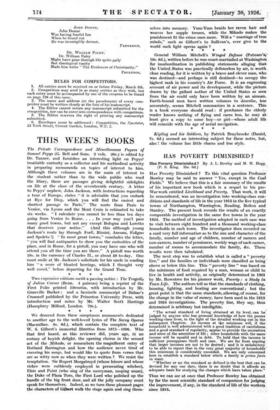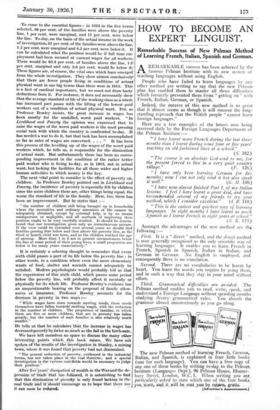HAS POVERTY DIMINISHED?
Has Poverty Diminished ? By A. L. Bowley and M. H. Hogg. (P. S. King. 10s. (3d.) Has Poverty Diminished ? By A. L. Bowley and M. H. Hogg. (P. S. King. 10s. (3d.)
HAS Poverty Diminished ? To this vital question Professor Bowley may be said to answer "Yes, except in the Coal Fields." We believe that this is a fair summary of the results of his important new book which is a sequel to his pre- War work entitled Livelihood and Poverty. That work, it will be remembered, was an investigation into working-class con- ditions and standards of life in the year 1913 in the five typical
towns of Northampton, Warrington, Reading, Bolton and Stanley. The present book records the results of an exactly, comparable investigation in the same five towns in the year 1924. The method of investigation adopted in each case was to visit between eight hundred and a thousand working-elms households in each town. The investigator then recorded on a card very full information as to the size and character of the family, number and age of children, number of earners and non-earners, number of pensioners, weekly wage of each earner, number of rooms to accommodate the family, &c. These results were then tabulated.
The next step was to establish what is called a " poverty line," and the families or individuals were classified as being above or below this line. This "poverty line" was based on the minimum of food required by a man, woman or child to
live in health and activity, as originally determined in 1901 by Mr. Rowntree for his pioneer work, Poverty : a Study in Town Life. The authors tell us that the standanis of clothing,
housing, lighting, and heating are conventional ; but the great point is that the same standards, allowing,of course, for the change in the value of money, have been used in the 1913 and 1924 investigations. The poverty line, they say, thus determined is arbitrary but intelligible.
" The actual standard of living obtained at its level, can be judged by anyone who has personal knowledge of how the poorer working-class lives, in the light of the detailed working out in the subsequent Chapters. An income at tie minimum will, if the household is well administered with a good tradition of carefulness and a good standard of regularity, appear to provide the necessities and some of the amenities of life ; other households with the same income will be squalid and in debt. To hold that the income is sufficient, presupposes thrift and care. We are far from arguing that larger incomes are not to be desired ; and it is satisfactory, to be able to report that in the Very great majority of households ' this minimum is considerably exceeded. We are only concerned here to establish a standard below which a family is prima facie
in want. - "Whether or no the standard so defined is the best that can be, devised for any one date, there is no doubt that it affords an adequate basis for studying the changes which have taken place."
Thus we can see at once that Professor Bowley has obtained by far the most scientific standard of comparison for judging the imprOvenctent, if any, in the standard of life of the workers since 1918. • To come to the essential-figures : in 1913 in the five towns- selected, .88 per cent. of the families were above the poverty
line, 1 per cent. were -Marginal, and 11 per cent, were below the line. To-day, on the ba§is of the actual income in the week
of investigation, 92 per cent, of the families were above the line, 1.5 per cent, were marginal and 6.5 per cent. were below it. It can be calculated what the position would be if full time em-
ployment had been secured at current wages for all workers:. There would-be -95.8- per cent. -of families above the line; LV per cent. marginal and -only 3.6 per cent. Would be below These figures Are, of tourse, the vital ones which have emerged' from the whole investigation. They show .ahnOst Conclusive!
that there are fewer people ' living' in conditions Of actual physical want in our big towns than there were in 1913.- This
is a fact of cardinal importance, but we must not draw hasty deductions from it. For instance, it does- not necessarilY show that the average standard of life of the working class as a whole has increased part passu with the lifting of the lowest paid workers out of nnondition of Actual physical want. For, as Professor Bowley insists, the great increase in wages has been mostly' for the unskilled, worst paid . workers. "In 'Livelihood and Poverty the opinion was expressed that to raise the wages of the worst paid workers is the most pressing
social task with which the country is confronted to-day. • It has needed a war to do it, but that task has been accomplished ,so far as rates of wages are concerned. . . . " It has been this process of the levelling up of the wages of the worst paid workers which, he tells us, is responsible for the diminution of actual Want. But unfortunately there has been no corres- ponding improvement in the condition of the rather_ better paid worker who is living to-day, as in 1913, not in actual want, but lacking the facilities for all those wider and higher human activities to Which Money is the key.
The next vital point to consider is the effect of poverty on, children. As professor Bowley pointed out in Livelihood and Poverty, the incidence of poverty is especially felt by children since the more children there are, other things being equal, the
worse the 'standard of life in the family. Here, too, there has been an improvement. But he states that :— _ _ _
"the number Of children still being brought up in households where the necessities and ordinary amenities of life cannot be adequately Obtained, except by external help, is by no means unimportant - or negligible, and all methods of improving their position ought. to. be very carefully studied. It should be remem- bered that our investigation gives only an instantaneous picture. If the view Could be extended over several years we should find families passing first below and then above the poverty line, as the third or fourth child was born, and as the children reached the age of earning. More than I in 6 are in present circumstances below the line at someperiod of their young lives, a small proportion are below it for many years consecutively."
It is certainly a sobering thought to remember that every sixth child passes A part of its life below the pOverty line ; in other words, in a condition where even the most elementary wants of food, shelter and warmth cannot adequately be
satisfied. Modern psychologists would- tell Us that the'experiencea Of this -girth which passes some period below the poverty line, Will probably affect it Mentally or physically for its whole life. Profess-or BOwley's evidence has azi unquestionable baring on, the proposal of family allow- ances or insurance. Professor Bowley accounts for the
. , „ . .
decrease in poverty in two _ways
While wages have risen towards meeting iieedji, these needs themselves have fallen towards' ineifiting wages, with the reduction in the number of children. The proportion of families, in which there are five or more children-, that are in poverty has fallen greatly, but the number of such families is also relatively much
He tells us that'he calculates thatthe increase in Wages has . _ decreased poyerfYby.fWiee asmuch as the fall in the birth-rate.
We have left ourselves no space to discuss the Many other interesting points which this :book raises. We have not spoken of the-result-a a the .fuveStigation in Stanley, a mining town, *hem it *as found that poverty had not diminished.
"The general reduction Of -poverty, evideneed in the industrial towns, has not taken place in the coal districts ; and a special investigation in the' various Coal-fields would be necessary to judge
their position." ' , • After fiVeYeaii'' dissipation Of wealth in the War and the de- .
prt.-sgoii of-tkade'thrii ha § followed, it is astonishing to find that this diminution- Of pbvet!ty is only found lacking in 'the coat trade 'and'it.-thOidd'encOurag,e us to hope that there too it can soon be reduced.



















































 Previous page
Previous page